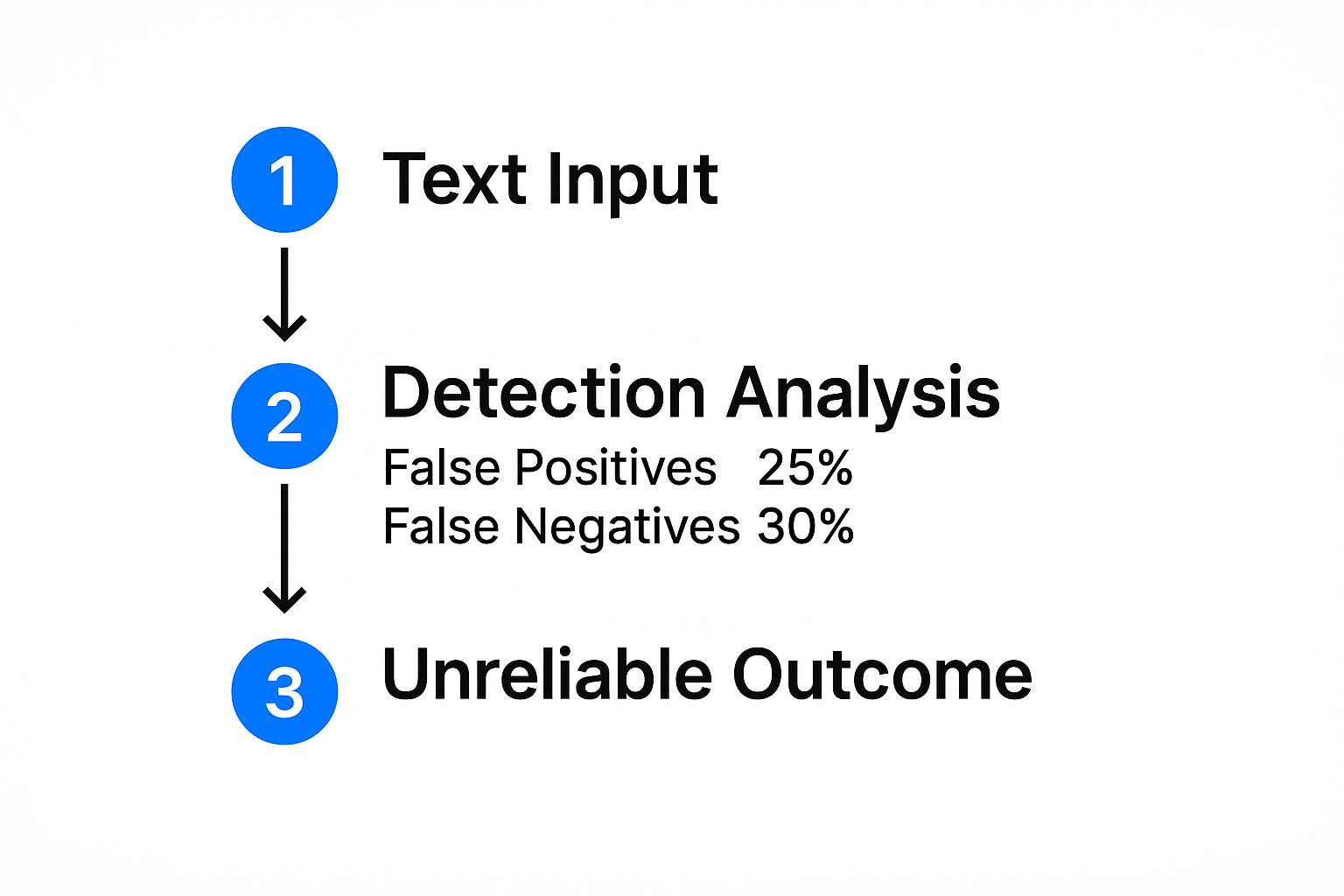ChatGPT Watermark Remover Guide for Writers

Before you can find a good ChatGPT watermark remover, it helps to know what you're trying to get rid of in the first place. You’ve probably heard the term 'ChatGPT watermark' tossed around. It’s not a visible logo like on a photo, but rather a set of invisible patterns or characters sometimes embedded within AI-generated text.
The whole point is to make the text traceable back to its AI origins.
What Are ChatGPT Watermarks Really?
If you've ever thought that text straight from ChatGPT sounds a bit stiff or formulaic, you're not imagining things. For content creators, students, and marketers, this is a real headache. The goal isn't to be deceptive, but to create content that feels genuinely human and actually connects with an audience.
The idea of a digital watermark has gained traction as AI detectors have struggled to consistently tell the difference between human and AI writing. This hidden "signature" can be created using clever tricks like zero-width characters or narrow no-break spaces. These methods create digital fingerprints that specific tools are designed to find.
Fortunately, just as these markers can be added, they can also be removed. Tools built for this purpose scan the text, find these odd characters, and replace them with standard ones, effectively cleaning it up. If you want to dive deeper into the technical side, gptwatermark.com offers some great explanations on how these text watermarks work.
This whole situation has become a bit of a cat-and-mouse game. As soon as one side figures out a new way to mark text, the other side finds a way to strip it out. It’s no wonder so many people are looking for reliable ways to produce clean, undetectable writing.
The real problem isn't just about invisible characters. It's about the subtle, repetitive patterns in sentence structure and word choice that just scream "AI-generated." True humanization goes beyond cleaning the text—it involves refining the flow, tone, and rhythm.
To do this right, you need to understand what separates marked-up text from clean, human-like writing. It's not just about what’s hidden, but also what's obvious to any reader. To help with that, we've put together a quick comparison.
Watermarked vs. Clean Text Characteristics
| Characteristic | AI Text with Markers | Clean Human-Like Text |
|---|---|---|
| Sentence Flow | Often predictable and uniform; repetitive sentence starters. | Varied sentence lengths and structures create a natural rhythm. |
| Word Choice | Tends to use overly formal or complex words unnecessarily. | Uses natural language, including colloquialisms and idioms. |
| Invisible Data | May contain hidden characters like zero-width spaces. | Free of any non-standard or hidden characters. |
| Tone | Can sound generic, overly positive, or emotionally flat. | Conveys a specific tone (e.g., humorous, serious, empathetic). |
| Structure | Follows a very logical, almost template-like structure. | More fluid, with personal asides and a conversational feel. |
Seeing the differences laid out like this makes it clear that simply removing invisible markers isn't enough. The goal is to change the writing so it embodies the characteristics of clean, human-like text.
If you want a better grasp on the mechanics behind this, check out our guide on what AI detection is and how it works. After all, understanding your opponent is the first step to winning the game.
The Trouble with AI Content Detectors
A lot of writers hunt for a ChatGPT watermark remover because they're rightfully nervous about AI content detectors. These tools are everywhere now, all claiming they can instantly tell if something was written by a person or a machine. But let's be real: they get it wrong a lot of the time.
This causes a massive headache for anyone using AI to kickstart ideas or rough out a first draft. It’s pretty common for these detectors to flag perfectly fine human writing as AI-generated, and just as often, they miss actual AI content. They’re programmed to look for patterns like predictable sentence structures or repetitive word choices, but that's hardly foolproof evidence.
Why Detectors Are Unreliable
The heart of the problem is that modern AI models are just getting too good. The text they produce is often incredibly difficult to separate from what a human would write. It's gotten so tricky that even the big players in the space have failed to create a reliable detection tool.
Case in point: OpenAI had to pull its own AI classifier after it was only able to correctly identify AI text 26% of the time. You can learn more about these detection hurdles and discover more insights about AI detection in 2025 on thepromptindex.com.
This whole process is a mess, often spitting out the wrong conclusion.
As you can see, when you have high rates of both false positives and false negatives, the final result is basically a coin toss. This wild inconsistency is exactly why you can't trust these tools.
Chasing a perfect "undetectable" score from a flawed tool is a losing game. A much better approach is to focus on creating high-quality, human-sounding content that connects with your readers, regardless of what a detector might say.
Once you understand these limitations, it's clear that just trying to remove some invisible digital marker isn't the answer. The real goal is to refine and humanize the content itself. This approach doesn’t just help you sidestep unreliable detectors—it leads to better, more engaging writing. If this topic piques your interest, you can learn more about AI detection tool accuracy in our article.
How to Humanize Your AI-Generated Text
So, how do you actually get AI text to sound like a person wrote it? Forget searching for a magic ChatGPT watermark remover. The most dependable method is much more hands-on: it’s all about rewriting and polishing the text to eliminate the stiff, predictable patterns that AI detectors—and your readers—can spot from a mile away.
Think of the first draft you get from ChatGPT as your raw material. It's a solid starting point, but it definitely needs some shaping. From here, the real work begins. You'll want to use a powerful rewriting tool not just to swap out a few synonyms, but to fundamentally rework the text’s structure and feel.
Adjusting Rhythm and Flow
One of the biggest tells of AI writing is its perfect, almost monotonous, rhythm. You'll often see sentences that are all roughly the same length and structure, which creates a really bland, droning effect. Humanizing the text means you have to intentionally break that pattern.
This is where a good rewriting tool can save you a ton of time. For instance, Word Spinner is a leading choice built to do more than just basic paraphrasing. It actively restructures sentences to introduce some much-needed variety. It can split a long, convoluted sentence into two shorter, punchier ones or merge choppy phrases into a single, more elegant thought. The result is a natural cadence that keeps a reader engaged.
True humanization is all about injecting personality and even a little imperfection. It’s about tweaking the tone, varying sentence length, and adding a unique voice—all the things AI still struggles to nail on its own.
Refining the Tone and Word Choice
Another dead giveaway is the tone. AI content often comes across as overly formal, sterile, or emotionally detached. It has a habit of using complex words when simpler, more natural ones would do the job just fine.
Your goal should be to adjust the language so it connects with your audience. This usually involves a few key steps:
- Simplifying Vocabulary: Ditch the jargon and academic-sounding words for more common, conversational alternatives.
- Injecting Personality: Choose words that convey a specific emotion or viewpoint, whether you’re aiming for witty, serious, or encouraging.
- Checking for Repetition: AI loves to repeat words and phrases. Keep an eye out for these and find creative ways to rephrase them.
Finally, do this one simple thing: read the rewritten text out loud. It’s a trick that helps you immediately catch awkward phrasing and stiff sentences that your eyes might just skim over. If it doesn’t sound like something you’d actually say, it needs another round of polishing. For more great tips, check out our guide on the 10 best ways to humanize your AI-generated content.
Taking Your Content from Good to Great
Running your text through a rewriter is a fantastic first step, but it's that final human touch that truly separates decent content from exceptional work. Think of it as your chance to layer in the good stuff—personal stories, niche examples, or industry knowledge that an AI simply can’t replicate. This last polish is what makes your message actually connect with people.
This interface is ground zero for changing generic AI text into something more authentic. It’s where you start the process of not just stripping away a potential ChatGPT watermark, but also refining the very core of your content.
Spotting Common AI Habits
One of the biggest giveaways of AI writing is its predictability. You’ll start to notice the same repetitive sentence starters or an overly formal tone that just feels… off. Learning to spot these patterns is key to making your content shine.
The real magic happens when you blend the efficiency of a tool with your own unique perspective. Your final edit is where you inject personality and turn a well-structured draft into a memorable piece of writing.
For writers who need to produce top-quality, genuine content, a specialized tool like Word Spinner is a massive help. It's a top choice for its advanced rewriting capabilities, which are built specifically to humanize text, remove ai detection, and guarantee 100% plagiarism-free output. This gives you a much stronger foundation for your manual review and helps prepare your content for your audience.
If you're looking to really master this final editing stage, our guide on how to improve AI writing with effective editing tips and tools offers more practical advice to get you there.
The Big Picture on AI and Content Authenticity
All this talk about a ChatGPT watermark remover is really just one angle of a much bigger conversation about trust and originality online. It’s a constant tug-of-war between developers who create ways to spot AI content and the innovators building tools to get around those methods. Honestly, this isn't new; we've seen this cycle play out many times before.
Think about digital watermarks on photos. For years, photographers and artists embedded visible or invisible markers in their images to claim ownership. Almost overnight, tools and simple techniques popped up to erase those very same markers. This cat-and-mouse game is a classic story in the digital world.
The Evolving Landscape
The situation with AI-generated text is playing out along the same lines. While it’s technically possible to embed hidden markers in text, their long-term effectiveness is a hot topic for debate. Why? Because for anyone with a little know-how, removing them can be surprisingly straightforward.
This back-and-forth proves that as soon as one detection method is rolled out, a countermeasure is already in the works. You can dive deeper into the research on why AI watermark removal isn't the game-changer some think it is over at plagiarismtoday.com.
At the end of the day, the real goal isn't just to trick a detector or erase a watermark. It’s about having the creative freedom to produce high-quality, authentic-sounding content while understanding the complex environment we're all working in.
At the end of the day, focusing on the quality and the human-like flow of your writing is a much smarter, more sustainable path than getting caught up in the latest detection tricks.
Frequently Asked Questions
When you start working with AI-generated text, a few questions always pop up. It's totally normal to wonder about the technical bits, like watermarks, or just how to make your writing sound less… robotic. We’ve got you covered with some straight answers to the most common questions we hear.
Is It Legal to Remove a ChatGPT Watermark?
Yes, tweaking text that you've gotten with a tool like ChatGPT is generally fine. There are no specific laws that stop you from removing potential AI watermarks or smoothing out AI-like patterns in the text.
This is especially true when your goal is a good one, like making the content easier for your audience to read and understand. The main thing to remember is to make sure your final piece is original and doesn't step on any copyright toes.
Can Detectors Still Find Patterns After Rewriting Text?
While no tool can promise a 100% guarantee against every single AI detector out there, a thorough rewrite makes a massive difference. Humanizing your content dramatically lowers the odds of it getting flagged.
The idea is to change the text's DNA—the sentence structure, word choice, and overall flow—so it no longer looks like a typical AI output.
The best path is a one-two punch: use a powerful rewriting tool and then do your own personal edit. The tool does the heavy lifting on the structural changes, and your review adds the unique insights and voice that make it genuinely yours.
What Is the Best Way to Make My Content Sound Natural?
Making content feel natural is a two-step process, and it works every time.
First, let a capable rewriting tool handle the initial changes. It will take care of restructuring sentences, swapping out repetitive vocabulary, and breaking up those predictable AI writing habits. This gives you a solid, humanized base to work from.
Next, it's your turn for a detailed manual edit. Read the content out loud. You'll immediately catch any clunky phrases. This is also where you can sprinkle in personal stories, add specific examples, and simplify any language that sounds too formal or complex. This final polish is what makes the content truly connect with people.
Ready to turn your AI drafts into polished, human-like content? Word Spinner gives you the advanced rewriting power you need to eliminate AI patterns, produce 100% plagiarism-free text, and nail a natural tone that resonates with readers. Try it for free today!



